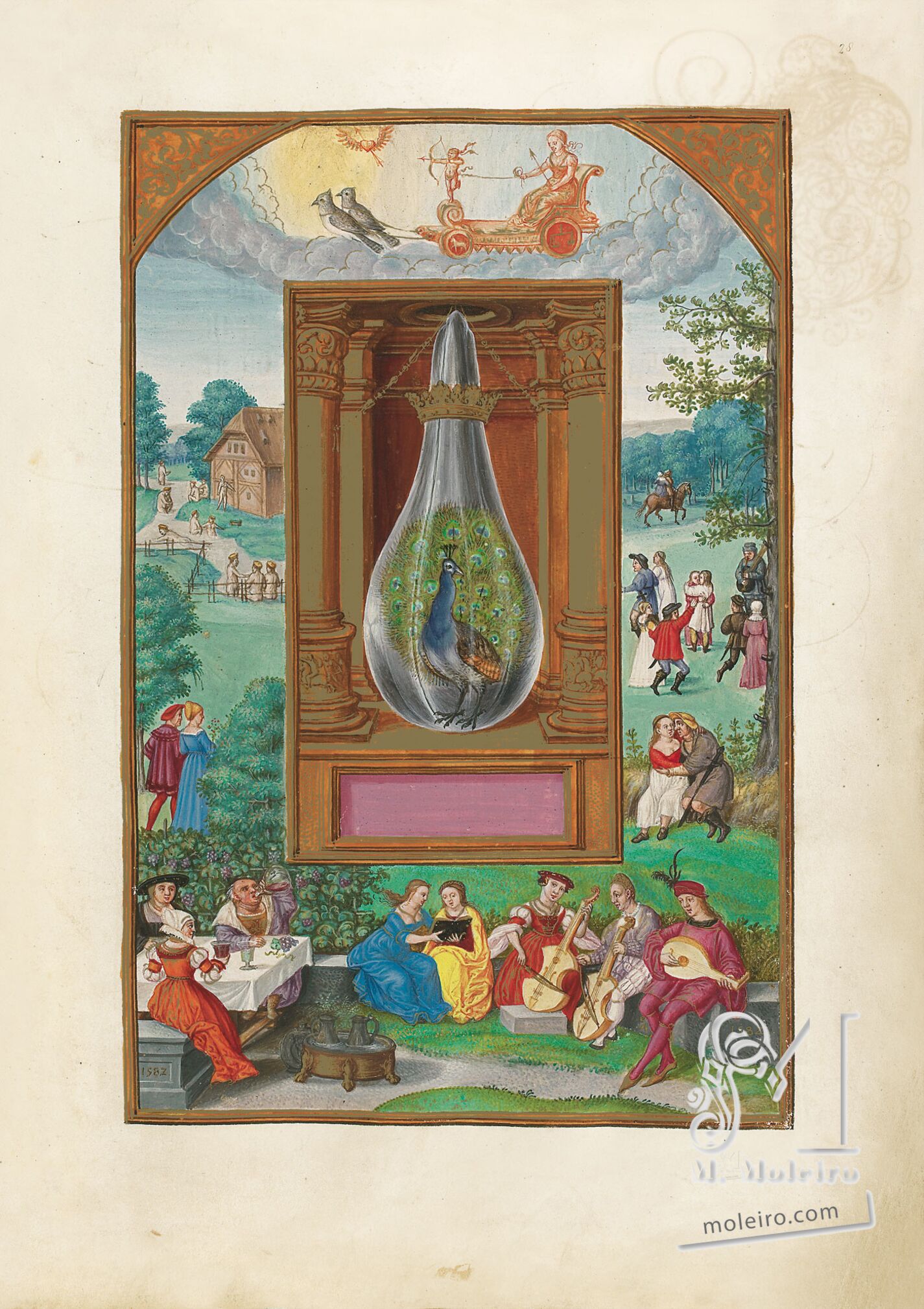As mentioned above, the Venus miniature, which is also dated 1582, should theoretically be fifth in the planet series. The rule of Venus is characterised by pleasure, amusement, joy and beauty. Surmounting the scenes of sensual activity is an image of the planetary goddess in her orange chariot with two doves harnessed to the front. In her left hand she holds an arrow as her attribute, while securing Amor with her right hand. Leashed and blindfolded, he is shown balancing on one leg upon the seat, poised to shoot an arrow with his bow. The depiction of the planetary goddess, enwreathed by clouds and illumined by a bright light, is accompanied by a winged heart which, pierced by an arrow, lingers in the sky like a leitmotif.
Around the inserted panel are compositions of various human activities in the outdoors. A courtly scene at the lower edge of the picture conveys corporeal and musical pleasures. The right-hand side is reserved for the simple, rural stratum of society, a rather unusual clientele for the children of Venus. Here, a peasant fair with a bagpiper and dancing couples is framed in the foreground by two lovers caressing in the shade of a tree and in the background by a couple setting out on a horse ride. The interior miniature centres on a niche composed of pilasters and protruding columns.
The flask inside the niche contains a magnificent peacock spreading its tail.In alchemy the peacock tail serves as a symbol of the shifting patterns of colour which become visible in the flask once a certain level of transmutation has been reached. Being a noble oiseau, a bird typically associated in the Middle Ages with the upper echelons of society, the peacock appears at the fifth level of the transmutation process in the realm of Venus. Venturing a full interpretation of the miniature, Petra Schramm regards the music-making, playing and dancing “planet-children” as a prelude to the “Chymical Wedding”, heightening the human capacity to love. As it happens, the two birds assigned to Venus were widely regarded as aphrodisiacs: peacock meat was believed to increase male potency and dove meat the willingness of women.
Jörg Völlnagel
(Art historian, research associate at the Staatliche Museen zu Berlin)

As mentioned above, the Venus miniature, which is also dated 1582, should theoretically be fifth in the planet series. The rule of Venus is characterised by pleasure, amusement, joy and beauty. Surmounting the scenes of sensual activity is an image of the planetary goddess in her orange chariot with two doves harnessed to the front. In her left hand she holds an arrow as her attribute, while securing Amor with her right hand. Leashed and blindfolded, he is shown balancing on one leg upon the seat, poised to shoot an arrow with his bow. The depiction of the planetary goddess, enwreathed by clouds and illumined by a bright light, is accompanied by a winged heart which, pierced by an arrow, lingers in the sky like a leitmotif.
Around the inserted panel are compositions of various human activities in the outdoors. A courtly scene at the lower edge of the picture conveys corporeal and musical pleasures. The right-hand side is reserved for the simple, rural stratum of society, a rather unusual clientele for the children of Venus. Here, a peasant fair with a bagpiper and dancing couples is framed in the foreground by two lovers caressing in the shade of a tree and in the background by a couple setting out on a horse ride. The interior miniature centres on a niche composed of pilasters and protruding columns.
The flask inside the niche contains a magnificent peacock spreading its tail.In alchemy the peacock tail serves as a symbol of the shifting patterns of colour which become visible in the flask once a certain level of transmutation has been reached. Being a noble oiseau, a bird typically associated in the Middle Ages with the upper echelons of society, the peacock appears at the fifth level of the transmutation process in the realm of Venus. Venturing a full interpretation of the miniature, Petra Schramm regards the music-making, playing and dancing “planet-children” as a prelude to the “Chymical Wedding”, heightening the human capacity to love. As it happens, the two birds assigned to Venus were widely regarded as aphrodisiacs: peacock meat was believed to increase male potency and dove meat the willingness of women.
Jörg Völlnagel
(Art historian, research associate at the Staatliche Museen zu Berlin)